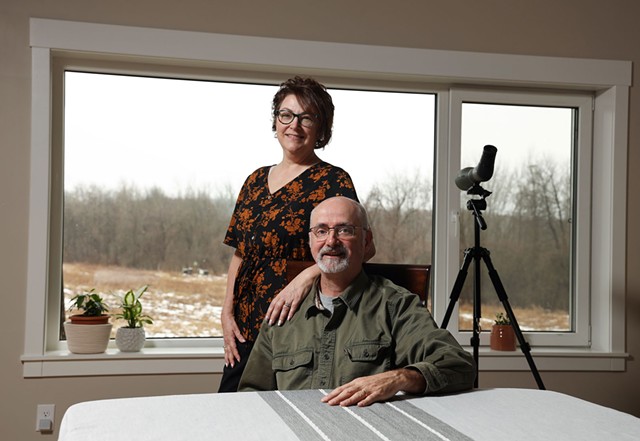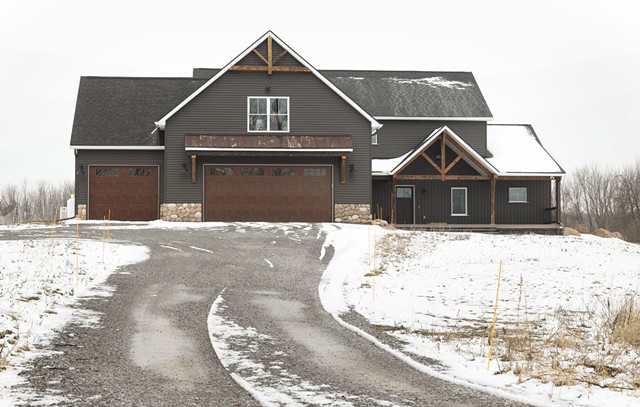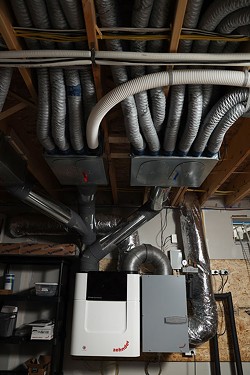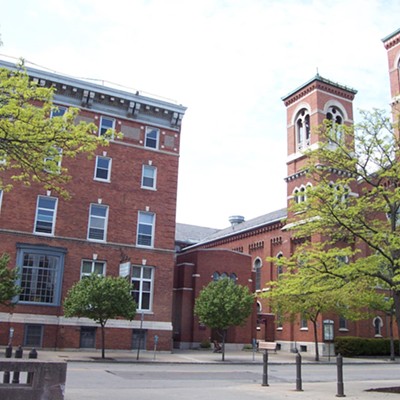[
{
"name": "500x250 Ad",
"insertPoint": "5",
"component": "15667920",
"parentWrapperClass": "",
"requiredCountToDisplay": "1"
}
]
When Joanna and Greg Collins considered building a new home in Lima, they didn’t exactly set out to build a “passive house” — one that maintains a comfortable interior climate without active heating and cooling systems.
For the Collinses, who had raised three sons to adulthood in Avon, their main priority wasn’t reaping the environmental benefits of cutting carbon or reducing energy use that come with “passive” living.
Their needs were much more practical: accommodating their medically fragile 7-year-old son and Greg’s 98-year-old father with accessible, first-floor living quarters.
But in discussing where to move and what to build, Greg recalled reading an article about a passive house and was drawn to the concept. He was also intrigued by the possibility of building a net-zero home — one that produces the amount of energy it consumes through a mix of factors, such as electrification, solar power, insulation, and eco-friendly heating and cooling systems (like a geothermal closed-loop system that draws on the earth’s temperature to manage the home’s temperature).
Strategies like these can make a home significantly more eco-friendly than the standard fuel-guzzler, which, over the course of two decades, can emit 120 tons of carbon dioxide. Buildings are thought to account for over a third of greenhouse gas emissions in the United States, and buildings in New York are considered among the worst culprits.
“I do feel an obligation from a social contract point to do what I can,” Greg said, “and that's partly for my children and for the future.”
It took Greg just a few minutes to find the passive house article, and just a few more to contact its subject, Matthew Bowers, who owns Rochester Passive House Consulting, and lives in a passive house in Honeoye Falls.
On a recent winter day, the temperature outside bottomed out at 16 degrees, but the interior of Bowers’ house was a comfortable 72. That is perhaps typical of most homes on a frigid winter day. Now consider that Bowers’ house spans 2,800 square feet and that he spends $300 a year to heat it.
“And we don’t have geothermal. We don’t have solar panels. It’s strictly using air-source heat pumps,” he said. “Essentially, two hair dryers put out enough heat to actually heat our house.”
Passive house construction, Bowers explained, can remedy issues such as cold floors, unwanted noise from outside, lingering odors from cooking, and even allergens floating around.
“The certification process for a passive house is to make sure that the thermal envelope — so that’s your floor, your walls, your roof, your windows — only can lose so much energy over the course of the heating season, and can only gain so much energy over the course of the summer season,” Bowers said.
Building a passive house from scratch, like the Collinses did (along with adding net-zero features), is much easier than retrofitting an existing home. The latter is possible, and experts figure it can reduce energy costs by 93 percent, but it is an involved renovation process that can take months and requires homeowners to vacate.
There are five principles of building a passive house from the ground up. The house must have:
• A super-insulated envelope (such as with cellulose insulation)
• Air-tight construction (sealing all leaks around doors, windows, and electrical outlets)
• No thermal bridges (a thermal bridge is an area with less insulation, such as the studs of a house — so to avoid this, dormers and bump-outs are minimized)
• Mechanical ventilation (ensuring healthy air quality)
• Efficient windows, orientation, and shading (triple-pane windows are common with passive houses, and the homes themselves are oriented to take full advantage of natural light and heat).
Though the idea of paying relatively low energy bills is enticing — and the environmental ethic is becoming more and more mainstream — the price of getting a passive home can be high. Building costs range anywhere from 10 percent to 20 percent above the home’s value.
But the arrangement has paid off for the Collins family, in more ways than just financially.
For Joanna, who is also a foster parent and animal rescuer, it is both her family and environmental health that motivate her the most. Given the ongoing climate crisis, her goal is to help normalize living sustainably.
“Family is everything for me,” she said. “My first granddaughter was born just last year, and I hope she has a future and an environment to live in when she gets older.”
For the Collinses, there is nothing even remotely passive about that.
Jasmin Singer is a reporter and WXXI News weekend radio host. She can be reached at [email protected].
Latest in News
More by Jasmin Singer
-
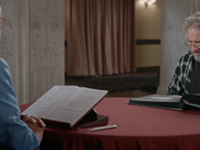
The hidden past of Sammy Hagar’s family
Jan 29, 2024 - More »
